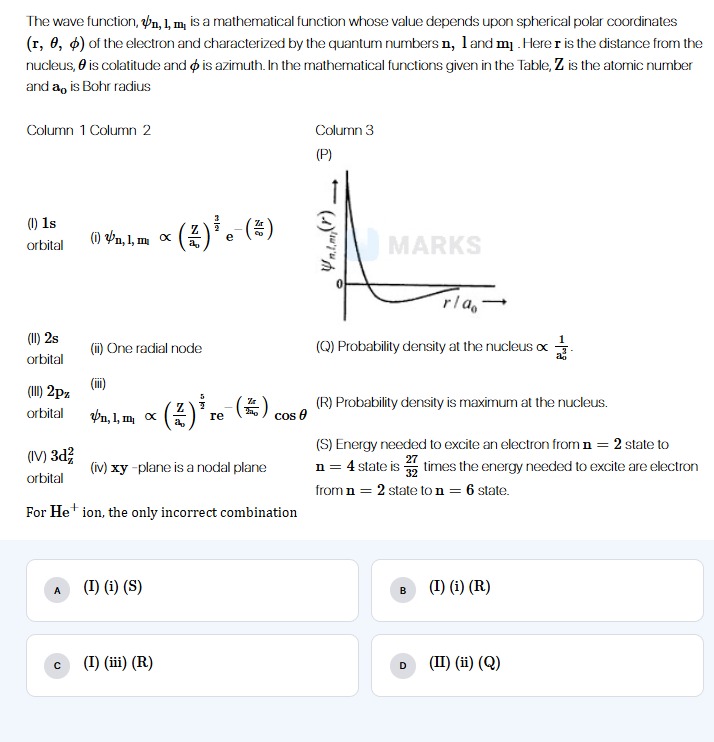Question
Question: The wave function, $\psi_{n,l,m_l}$ is a mathematical function whose value depends upon spherical po...
The wave function, ψn,l,ml is a mathematical function whose value depends upon spherical polar coordinates (r,θ,ϕ) of the electron and characterized by the quantum numbers n, l and ml. Here r is the distance from the nucleus, θ is colatitude and ϕ is azimuth. In the mathematical functions given in the Table, Z is the atomic number and a0 is Bohr radius
Column 1 Column 2 Column 3 (P)
(I) 1s orbital (i) ψn,l,ml∝(a0Z)23e−(a0Zr) (Q) Probability density at the nucleus ∝a031.
(II) 2s orbital (ii) One radial node
(III) 2pz orbital (iii) ψn,l,ml∝(a0Z)25re−(a0Zr)cosθ (R) Probability density is maximum at the nucleus.
(IV) 3dz2 orbital (iv) xy-plane is a nodal plane (S) Energy needed to excite an electron from n=2 state to n=4 state is 3227 times the energy needed to excite are electron from n=2 state to n=6 state.
For He+ ion, the only incorrect combination

(I) (i) (S)
(I) (i) (R)
(I) (iii) (R)
(II) (ii) (Q)
C
Solution
Let's analyze each option.
Option A: (I) (i) (S)
- (I) 1s orbital. (i) ψ1s∝(a0Z)23e−(a0Zr). This is the correct form of the 1s wave function.
- (S) Energy needed to excite an electron from n=2 state to n=4 state is 3227 times the energy needed to excite an electron from n=2 state to n=6 state. For a hydrogen-like ion, En=−n213.6Z2.
- ΔE2→4=E4−E2=13.6Z2(221−421)=13.6Z2(41−161)=13.6Z2163.
- ΔE2→6=E6−E2=13.6Z2(221−621)=13.6Z2(41−361)=13.6Z2368=13.6Z292.
- ΔE2→6ΔE2→4=2/93/16=163×29=3227. Statement (S) is correct.
Combination (I) (i) (S) is correct.
Option B: (I) (i) (R)
- (I) 1s orbital. (i) ψ1s∝(a0Z)23e−(a0Zr). Correct.
- (R) Probability density is maximum at the nucleus. Probability density ∣ψ∣2∝e−2Zr/a0. At r=0, ∣ψ∣2∝1, which is the maximum value as e−2Zr/a0 decreases as r increases for r>0. Statement (R) is correct for 1s orbital.
Combination (I) (i) (R) is correct.
Option C: (I) (iii) (R)
- (I) 1s orbital. (iii) ψ∝(a0Z)25re−(a0Zr)cosθ. This is not the wave function for a 1s orbital. For a 1s orbital, l=0, so the angular part is constant, and the radial part is proportional to e−Zr/a0. The given function has an angular part proportional to cosθ (corresponding to l=1,ml=0) and a radial part proportional to re−Zr/a0. This radial part is not for n=1 or n=2,l=1.
Since (I) and (iii) is an incorrect combination, the entire combination is incorrect.
Let's also check (iii) and (R). For the wave function in (iii), ψ(r=0)=0 because of the factor r. So, the probability density at the nucleus is zero. Thus, the probability density is not maximum at the nucleus. (iii) and (R) is an incorrect combination.
Therefore, combination (I) (iii) (R) is an incorrect combination.
Option D: (II) (ii) (Q)
- (II) 2s orbital. (ii) One radial node. For 2s orbital, n=2,l=0. Number of radial nodes = n−l−1=2−0−1=1. Statement (ii) is correct for 2s orbital.
- (Q) Probability density at the nucleus ∝a031. The wave function for 2s orbital is ψ2s∝(a0Z)23(2−a0Zr)e−Zr/2a0. At r=0, ψ2s(0)∝(a0Z)23(2)e0=2(a0Z)23. The probability density at the nucleus is ∣ψ2s(0)∣2∝(2(a0Z)23)2=4(a0Z)3=4a03Z3. This is proportional to a031. Statement (Q) is correct for 2s orbital.
Combination (II) (ii) (Q) is correct.
We are looking for the only incorrect combination. Option C is an incorrect combination.
Final check:
- Option A: (I) 1s, (i) 1s wave function, (S) Energy ratio. All are correct.
- Option B: (I) 1s, (i) 1s wave function, (R) Probability density max at nucleus for 1s. All are correct.
- Option C: (I) 1s, (iii) wave function which is not 1s, (R) Probability density max at nucleus. Incorrect.
- Option D: (II) 2s, (ii) One radial node for 2s, (Q) Probability density at nucleus ∝1/a03. All are correct.
Since the question asks for the only incorrect combination, Option C is the answer.
